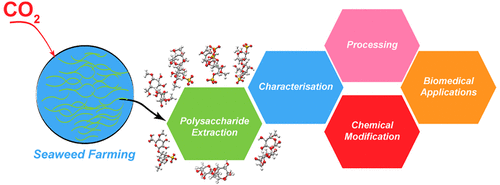
28. Hydrogel-Forming Algae Polysaccharides: From Seaweed to Biomedical Applications
February 2021
Marco Beaumont, Remy Tran, Grace Vera, Dennis Niedrist, Aurelie Rousset, Ronan Pierre, V Prasad Shastri, Aurelien Forget
With the increasing growth of the algae industry and the development of algae biorefinery, there is a growing need for high-value applications of algae-extracted biopolymers. The utilization of such biopolymers in the biomedical field can be considered as one of the most attractive applications but is challenging to implement. Historically, polysaccharides extracted from seaweed have been used for a long time in biomedical research, for example, agarose gels for electrophoresis and bacterial culture. To overcome the current challenges in polysaccharides and help further the development of high-added-value applications, an overview of the entire polysaccharide journey from seaweed to biomedical applications is needed. This encompasses algae culture, extraction, chemistry, characterization, processing, and an understanding of the interactions of soft matter with living organisms. In this review, we present algae polysaccharides that intrinsically form hydrogels: alginate, carrageenan, ulvan, starch, agarose, porphyran, and (nano)cellulose and classify these by their gelation mechanisms. The focus of this review further lays on the culture and extraction strategies to obtain pure polysaccharides, their structure-properties relationships, the current advances in chemical backbone modifications, and how these modifications can be used to tune the polysaccharide properties. The available techniques to characterize each organization scale of a polysaccharide hydrogel are presented, and the impact on their interactions with biological systems is discussed. Finally, a perspective of the anticipated development of the whole field and how the further utilization of hydrogel-forming polysaccharides extracted from algae can revolutionize the current algae industry are suggested.